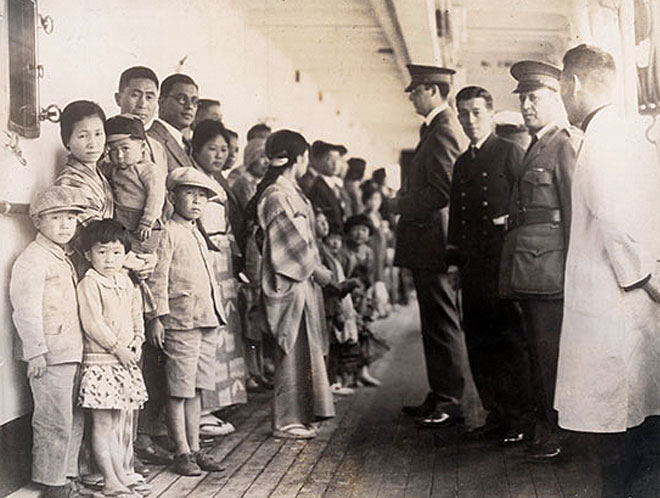May 25, 2019
The Immigration Act of 1924 created a national origins quota for the first time in U.S. history, and a complete and total ban on Japanese immigration. Building on a half-century of anti-Asian laws and policies, the bill enacted what we might today call a “Japanese Ban.” Almost 100 years later, as lawmakers continue to criminalize and exclude non-white, working-class immigrants, the history behind this early immigration ban should be both a warning and a call to action.
The Immigration Act of 1924 (also known as the Johnson-Reed Act) was a nativist response to increased immigration from “undesirable” countries. Its primary target was Jews, Italians, Slavs, and Greeks—but West Coast politicians used it as an opportunity to solve the “Japanese Problem.” The Act capped new immigration at two percent of the total number of individuals from each nationality in the U.S. in 1890—before major immigration from Eastern and Southern Europe. It also created an outright ban on Japanese immigration.
Asian immigrants had been the target of racist and xenophobic politicians for decades leading up to 1924. The Page Act of 1875, the country’s first restrictive immigration law, prohibited the entry of Chinese women to the United States on the both racist and sexist assumption that all were sex workers. Five years later, the Chinese Exclusion Act closed the borders to Chinese men as well. The Gentlemen’s Agreement of 1907 barred Japanese laborers. And the “Asiatic Barred Zone Act” (yes, you read that correctly) of 1917 banned migration from most of the continent of Asia and the adjacent islands — except for Japan and Northern China, as Japanese and Chinese laborers were already barred from entry.
Filipino immigration remained legal because, well, imperialism. Since the Philippines had been violently annexed as a U.S. territory, Filipino citizens were considered U.S. nationals and allowed entry. This exception to the rule should not be mistaken for an example of state benevolence.
The Immigration Act of 1924 was essentially a Japanese Ban. It was the culmination of earlier policies to restrict immigration from Asia, and became a tool in ongoing efforts to criminalize Asian immigrants already residing in the United States.
Like all travel bans, the Johnson-Reed Act did nothing to address the root causes of migration, and Japanese immigrants desperate to enter the U.S. found creative — and often dangerous — means of subverting the ban. In the 1960s, Japanese journalist Kazuo Ito interviewed Issei in both the Pacific Northwest and Japan about their early lives in America, and found many examples of “secret passage and ship-jumping.” And many Nisei, like May Ota Higa below, recount their own parents’ stories of sneaking into the U.S. via the Mexico or Canada border.
The restrictions of the Johnson-Reed Act, and the earlier Gentlemen’s Agreement, didn’t stop Japanese immigration, but they did make the journey to America less safe for those who undertook it. An Issei priest at the U.S./Mexico border in the 1910s and 1920s, recalled:
“At that time I found that there were many Japanese smuggling-in to the State from Mexican territory. I also learned that many couldn’t make it to America, collapsing in the desert country and dying in their tracks. Some could make their way to the states with the assistance of fellow-Japanese, but their ‘sponsors’ continuously threatened them with being reported to the Immigration Office in case of refusal to obey. Those who tried to steal in from Mexico literally risked their lives. Hundreds of Japanese were scattered over that area just waiting for a chance to cross the border.”
The references to would-be immigrants dying as they navigate the unforgiving Sonoran Desert and falling prey to exploitative coyotes ring deadly familiar to the current human rights crisis unfolding on our southern border — particularly as we learn more details about the extent of Border Patrol cruelty toward migrants following in the literal footsteps of these Issei pioneers.
Immigration bans have always been about weaponizing white fears and criminalizing vulnerable, desperate people. Today’s Muslim Ban, family concentration camps, and other attempts to restrict non-white and working-class immigrants are part of a much longer and larger history.
Rep. Albert Johnson, who wrote the 1924 Immigration Act, said during debate on the bill, “It has become necessary that the United States cease to become an asylum.” Attempts to deny U.S. responsibility for asylum-seekers — many of them escaping violence and unrest caused by U.S. foreign policies — are nothing new.
V.S. McClatchy, a leader of the anti-Japanese exclusion movement in California, cited Japanese immigrants’ “unassimilability” and “astronomical birth rate” as justification for the 1924 ban. We must remember that these racist, misogynist arguments are over a century old when we witness politicians dusting them off to wield against immigrants today.
And most importantly, we must remember that anti-immigrant politics — and the hateful, dehumanizing language used to justify them — have real, often deadly consequences for the people being targeted.
For Mariee Juarez, for Jakelin Caal Maquin, for Carlos Gregorio Hernández Vásquez, for Felipe Goméz Alonzo, for Juan de León Gutiérrez, for Wilmer Josué Ramírez Vásquez, for all the unnamed victims of militarized borders and immigration bans—we must remember, and we must act.
—
By Densho Communications Coordinator Nina Wallace
[Header photo: Japanese immigrants being examined by U.S. immigration officials aboard a ship docked at Angel Island (Image courtesy of the National Archives, Washington, D.C.)]

